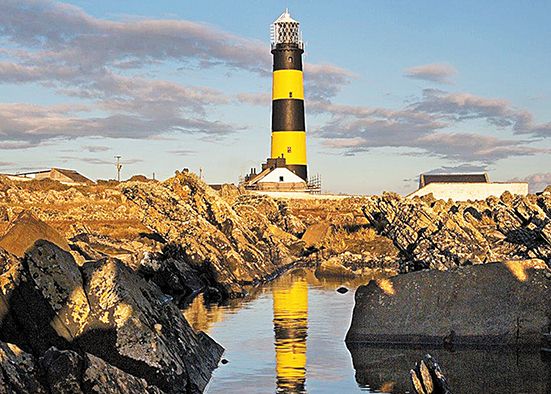Threat to lighthouse beam
Threat to lighthouse beam
26 June 2024

NEWRY, Mourne and Down Council has been asked to continue its support for the community campaign to retain the iconic sweeping beam at St John’s Point lighthouse in Killough.
The Dublin-based Commissioner of Irish Lights (CIL) has lodged a formal bid to secure listed building consent to remove the beam and replace it with a low energy LED alternative.
As part of the controversial application, permission is also being sought to remove a mercury bath on which the giant Fresnel lamp rotates and replace it with a rotating ball bearing mechanism.
Claims that the mercury bath poses a health risk have been dismissed as a “red herring” by the Lecale Lightkeepers, the group set up to oppose plans to replace the 1000 watt bulb with the LED alternative.
CIL’s application is being examined by local planners with campaigners writing to the local authority asking the organisation’s Planning Committee to refuse any approval recommendation and for the organisation to double down on its support for retaining the beam.
The Lecale Lightkeepers want the historic lens retained for current and future generations and its place in the maritime history of the area cemented for decades to come.
Campaigners have consistently argued they are vehemently opposed to any attempts to replace the rotating beam with a less effective LED light, while CIL wants replace the current light source which it claims is nearing end of its life.
Previously, the organisation has insisted the existing 1000W high energy lamp will soon become unavailable due to energy efficiency regulation changes which will make it impossible to source.
CIL said while the existing light will be replaced with an LED, the Fresnel optic will be retained, with the new light ensuring the ongoing safe and reliable operation of this aid to navigation.
In their letter to the local authority, campaigners have appealed to the organisation not to renege on its support for the battle to protect the historic light in its present mechanism, arguing that fitting LEDs at other lighthouses has not been successful.
Campaigners say CIL will undoubtedly argue that it has gone some way to meet their earlier demand to “leave well alone” and preserve the iconic sweeping beam which has been efficiently produced by the historic existing apparatus.
They say while CIL is now proposing to retain the historic glass Fresnel lens, it plans to remove its equally historic Bourdelles rotation system because of its “unjustified claim about the toxic danger of mercury in this equipment”.
Campaigners say the rotation system is in a lighthouse located in a breezy location on a maritime headland 100 feet above the ground in a well ventilated, unmanned, double locked tower in a cool temperate climate, and held in a covered cast iron trough.
Campaigners also point to a toxicological study at the Split Rock lighthouse in Minnesota where a mercury flotation system is employed which showed it is does not present a danger to human health, as long as normal maintenance procedures are followed.
“There are no known (to us) instances of any illness or death amongst CIL lighthouse keepers or their families in decades of daily use of this efficient and low cost equipment,” the letter continues.
“CIL never issued any special training or health warnings throughout these decades. Liquid mercury does not vaporise easily and is not readily absorbed dermally.”
Campaigners say they can’t see how CIL’s case for replacement of mercury is justified on health and safety or even cost grounds, asking why it now has a “bee in its bonnet” about Bourdelles’ system and it’s mercury.
“This is a highly efficient mechanism requiring no lubrication and hardly any maintenance, unlike the ball bearing (metal on metal ) system which CIL proposes to replace it with,” the letter points out.
“The answer is that its usage is in an apparatus that doesn’t fit its latest standard model of lighthouse design, despite it’s mercury flotation efficiency and low cost operation.”
Campaigners say the current light produces an iconic and characteristic “loom” or halo around the beam, which enables it to be seen over the horizon which is not readily seen with an LED which has a shorter range, is markedly different in colour and not characteristic of the existing light beam.
The campaigners’ letter points to an environmental study that has shown that LED light has a detrimental effect on shoreline maritime life and on night-time bird behaviour and the natural activity of insects, bats and foxes.
It continues: “CIL insists it is ‘not in the heritage business’ but primarily in the provision of Aids to Navigation around the Irish Coast.
“Lighthouses are still vital to all types of mariners, although lighthouse keeping has disappeared forever. The original keeper station accommodation is largely unoccupied and in many locations, is not being maintained by CIL and abandoned to dilapidation.
Campaigners say lighthouses are “towering, iconic, characteristics of coastlines everywhere” and “tourist attractions like no other”.
Their letter adds: “Lecale Lightkeepers fully understand the need to modernise, but draw the line at the destruction of the sweeping beam that these iconic buildings — most of which are listed — produce.
“The lens and rotation equipment are masterpieces of Victorian optical and mechanical engineering and cause people to wonder at the ingenuity of our Victorian forebears.”
“Tourists must be able to appreciate the historic status of St John’s Point lighthouse. There is a need to preserve as much of the original remaining lighting equipment as possible, especially as it is still highly efficient, economic and produces a “amous, magnificent sweeping beam in the tallest lighthouse on mainland Ireland.”


